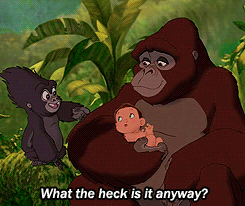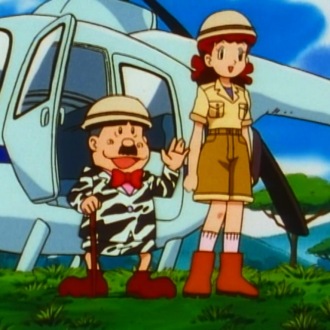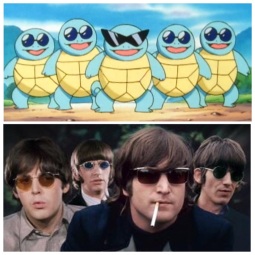You know, this episode should’ve been really good. It should’ve been really interesting and potentially powerful. Just goes to show you how wackiness isn’t always good, and voice acting is really important. Also maybe shows that I’m getting old in the soul? Anyway, this episode was really annoying but I should probably talk about it, so let’s get this over with.
The gang arrives in a protected reserve and encounters a herd of the massive, bipedal, armored marsupial ‘mon called kangaskhan. They’re known as “the parent pokémon” because of their pouches, which always seem to contain a baby. Team Rocket shows up to tries and nab a bunch of ’em because they are Very Bad People. Despite the fact that the Officer Jenny who patrols the reserve carries an actual rifle (yikes), it takes this spiky haired, leopard-skin-clad minidude with a boomerang to literally swing in and save the day. It’s Tomo, the human raised by pokémon–the pokéverse’s version of Tarzan, apparently. (The boomerang is a nice touch, though, since the Australian-ness it evokes goes well with the marsupial pouch of kangaskhans.)
pokémon” because of their pouches, which always seem to contain a baby. Team Rocket shows up to tries and nab a bunch of ’em because they are Very Bad People. Despite the fact that the Officer Jenny who patrols the reserve carries an actual rifle (yikes), it takes this spiky haired, leopard-skin-clad minidude with a boomerang to literally swing in and save the day. It’s Tomo, the human raised by pokémon–the pokéverse’s version of Tarzan, apparently. (The boomerang is a nice touch, though, since the Australian-ness it evokes goes well with the marsupial pouch of kangaskhans.)
Who is this mysterious stranger-child who rides away in a kangaskhan pouch and can communicate with his herd? The question is answered when these weird ass people emerge from the bush and announce that they’re looking for their long-lost son, Tommy! (COINCIDENCE? UNFORTUNATELY NOT!) Tomo is actually Tommy, a child lost when his wilderness lovin’, freaky lookin’ dad DROPPED HIM OUT OF A HELICOPTER.
a child lost when his wilderness lovin’, freaky lookin’ dad DROPPED HIM OUT OF A HELICOPTER.
Our gang of ecologically irresponsible do-gooders joins the search for Tomo/Tommy and, when they find him, his parents try to explain the situation to the child who one, doesn’t remember them and two, seems to be a lot safer with the non-humans who never dangle him out of helicopters geez frickin’ louise why would he ever go with his “real” parents?
Tomo has difficulty distinguishing humans from non-humans and asks Misty, “You  people or pokémon?” He must have encountered humans, i.e. “people,” and… somehow he has learned the discourse of species and humanism well enough to know that “people” and “pokémon” are different categories. He doesn’t know humans well enough to recognize them right off, and that isn’t surprising, since his dad looks like a ditto transformation gone wrong and also wears animal-print clothing and also a Hitler ‘stache. I really don’t blame Tomo for being confused.
people or pokémon?” He must have encountered humans, i.e. “people,” and… somehow he has learned the discourse of species and humanism well enough to know that “people” and “pokémon” are different categories. He doesn’t know humans well enough to recognize them right off, and that isn’t surprising, since his dad looks like a ditto transformation gone wrong and also wears animal-print clothing and also a Hitler ‘stache. I really don’t blame Tomo for being confused.  Look at this guy:
Look at this guy:
. . . . . . . . . . . . . . . . . . . um . . . . . . . . . .
Again, Tomo/Tommy has difficulty recalling his parents. When Misty prompts him to try and remember his parents from before, all he can think of is time spent with his herd–sleeping in the pouch, carried across the plains, lulled to sleep as the herd sings a pokémon song. As he thinks about the family he’s grown up with, his dad hits him really hard over the head with a log and chirps, “We’ll just take him home and start from scratch.” This man should not be a parent.
The blow to the head seems to jog Tomo’s memory, because he clutches his head in existential (and probably literal) pain and shrills in his annoying voice: “Tomo mama kangaskhan. But this lady Tomo mama too. … Tomo head feel bad!”
His crisis/concussion is interrupted by Team Rocket, formulaic defeat of the villains happens, the bad parents see how much their son cares about his adoptive family and crash their helicopter to help defeat TR and protect the herd. Then they decide to put on tiger skins and live with the herd so that Tomo/Tommy can be with his kangaskhan family: “Let Mama and Papa join your family, Tommy,” his terrible father asks. The next day Ash and co. wave goodbye to the family, who respond by shouting, “Kangas kangas kangas-khan!”
Look, this episode is really annoying, largely because of Tommy’s voice and stilted speech (and also because of that Hitler-stached father), but there’s something weird and maybe Freudian going on. Notably, the human parents accept, even affirm Tomo/Tommy’s partial non-humanity. They sacrifice not only the trappings of humanity (i.e., what makes them appear to Tomo as “people”), putting on animal flesh and speaking animal language, but also a part of their parental status. They’re in the pouch with Tomo/Tommy and his adoptive poké-sibling, the cradling pouch meant for the children of “the parental pokémon.” They’ve given up part of their authority and joined the larger community, the herd, of non-humans that their child loves.
This is kind of cool, and shows that although there’s a system of enslavement and bloodsports in place, in the pokéverse the thing that sets humans apart from non-humans isn’t some innate essence of specialness but rather, one would assume, lifestyle and power. Culture or nurture, if you will. Because nurture, not nature (essence) is what determines how someone identifies species-wise, the parents putting themselves in the (literal) position of juvenile kangaskhan makes their decision more significant. Not only is Tomo able to continue to occupy a space somewhere between kangaskhan and human, but it’s implied that his parents are doing more than just camping out to be near their son. They’re making a decision to reshape themselves, to be nurtured into new, hybrid beings.
This episode, like I said, could have been really interesting. However, I’m thinking of making a list of the best/most significant episodes as I go, and this one will not be on it because I cannot stress how irritating Tomo/Tommy and his father are. As interesting as the ep.’s implications are, it’s just not worth it? Oy.


 prompts the Swarm to withdraw. An acknowledgement of different needs, moralities and perspectives enables a truce. Not a peace–as I mentioned last week, Tentacruel warns that it will have its eye out for human incursion. But this is, I think, Morton’s “vibrating I.” The way the conflict ends is, for Pokémon, fairly subtle, as the difference is never re/dissolved completely. Instead Tentacruel realizes that humans might be capable of change and empathy; Misty and the others acknowledge that non-humans have needs and claims that conflict with and take precedence over human ends. It’s a moment of connection and communication.
prompts the Swarm to withdraw. An acknowledgement of different needs, moralities and perspectives enables a truce. Not a peace–as I mentioned last week, Tentacruel warns that it will have its eye out for human incursion. But this is, I think, Morton’s “vibrating I.” The way the conflict ends is, for Pokémon, fairly subtle, as the difference is never re/dissolved completely. Instead Tentacruel realizes that humans might be capable of change and empathy; Misty and the others acknowledge that non-humans have needs and claims that conflict with and take precedence over human ends. It’s a moment of connection and communication. This scene is particularly weird and important. So many characters cross their categorical boundaries that most end up in some confused middle ground of existence. First, by using Meowth as a translator, the Swarm is mimicking the way humans use pokémon. This confuses the human/pokémon dichotomy, usually clearly marked by who is using whom. Tentacruel and the Swarm here cross that line, using Meowth’s body so that they can clearly confront the humans in English.
This scene is particularly weird and important. So many characters cross their categorical boundaries that most end up in some confused middle ground of existence. First, by using Meowth as a translator, the Swarm is mimicking the way humans use pokémon. This confuses the human/pokémon dichotomy, usually clearly marked by who is using whom. Tentacruel and the Swarm here cross that line, using Meowth’s body so that they can clearly confront the humans in English. This is really interesting. Voluntarily releasing a pokémon into the wild so that the breeding cycle can continue outside of human control is probably the most positive interaction with pokémon we’ve seen, for one thing. Humans here play an active role in the lives not only of individual butterfree but the species as a whole, participating in the ecological rhythms of the non-human world.
This is really interesting. Voluntarily releasing a pokémon into the wild so that the breeding cycle can continue outside of human control is probably the most positive interaction with pokémon we’ve seen, for one thing. Humans here play an active role in the lives not only of individual butterfree but the species as a whole, participating in the ecological rhythms of the non-human world.  to “eighty prey” at a time. Add that to what Brock says in the episode, that “tentacool are known as the gangsters of the sea,” and how Ash quips that “Tentacruel must be their gang leader,” and I immediately got suspicious. Hook-nosed; elusive leader of an unseen cabal; covered in those “jewels” on the top of its dome; grasping and greedy with its many secretive, stretching tentacles; explicitly presented as Nastina’s economic enemy; these are all fairly common anti-semitic tropes. I looked into it and can’t find anything out there about tentacruel as a racialized cahracter. There are other pokémon that are problematic (see the large-lipped, dark-faced
to “eighty prey” at a time. Add that to what Brock says in the episode, that “tentacool are known as the gangsters of the sea,” and how Ash quips that “Tentacruel must be their gang leader,” and I immediately got suspicious. Hook-nosed; elusive leader of an unseen cabal; covered in those “jewels” on the top of its dome; grasping and greedy with its many secretive, stretching tentacles; explicitly presented as Nastina’s economic enemy; these are all fairly common anti-semitic tropes. I looked into it and can’t find anything out there about tentacruel as a racialized cahracter. There are other pokémon that are problematic (see the large-lipped, dark-faced  they had somebody to care about them, they wouldn’t have turned out to be as bad as they are.” She makes them sound like troubled, fatherless youths.
they had somebody to care about them, they wouldn’t have turned out to be as bad as they are.” She makes them sound like troubled, fatherless youths.



